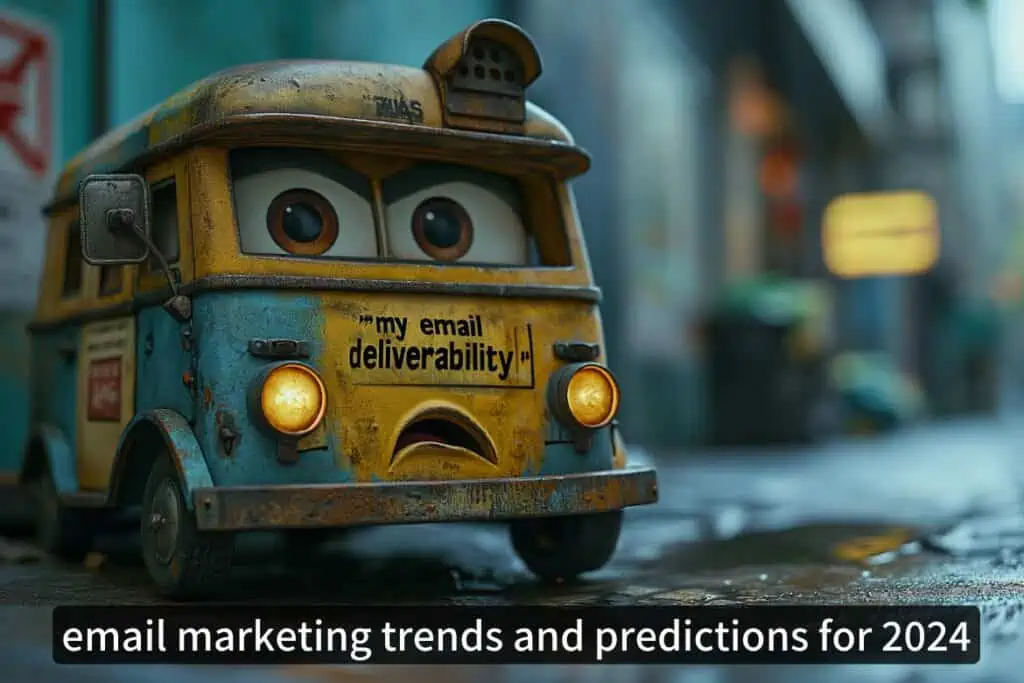Are words like "free" or "promotion" marked as "spammy" and put emails in a spam box?
תוכן עניינים
האזנה לפודקאסט
Over the years, it has been found that certain words known as “spammy words” such as “free” or “discount” may cause emails to be sent directly to the spam box. The recommendation also appears in recent articles. Should they be believed?
The Evolution of Spam Filtering
In an interview for my podcast, I spoke with Chad S. White of Oracle Marketing Consulting about the evolution of spam filtering deliverability. He is also the author of the book “Email Marketing Rules” which has just been released in its fourth expanded and updated edition.
In a recent article, he describes the five generations of email deliverability. I asked him to describe them and predict what the next generation would be.
Over the years, each time a new generation of spam filtering was added, previous generations were built on top of it as an additional layer. This created the multi-layered spam filtering we know today.
The first generation – the “Wild West” era. There were no rules and no email filtering. It was possible to mail without restriction.
The second generation – filtering IP addresses of mailing servers using RBL – Real Time Blacklist. Use of spammy words, feedback loops – “Report spam” button.
The third generation – the era of quality versus quantity. In order to overcome a phenomenon in which sophisticated mailers added a huge amount of emails from inactive recipients to each mailing, which relatively reduced the percentage of spam reports out of all emails sent. To overcome this, email providers have added engagement-based email filtering.
The fourth generation – relies on the reputation of domains and not only on the reputation of IP addresses and engagement (positive, negative, neutral) which continues to be a significant factor.
The fifth generation (the current generation) – Mailers are forced to navigate somewhat blindly without clear engagement metrics of opening emails due to Apple’s privacy change (
Apple MPP
). It is possible that in the future,
click-through data will also be disrupted
. Such disruption already exists in mailings to part of the B2B sector.
The next generation of spam filtering will be influenced by privacy regulations and laws that meet customer expectations. In countries where privacy laws have been regulated, there has been an increase in inbox arrivals. He said these things to me in an interview on the podcastGuy Hanson, VP at Validity, citing Brazil as an example.
האזנה לפודקאסט

פודקאסט ובלוג העוסקים בנושאי אימייל מרקטינג (email marketing), עבירות אימיילים (deliverability) ושיווק.
הגעתם אל הבלוג והפודקאסט המובילים והמעודכנים ביותר בעברית בנושא אימייל מרקטינג ועבירוּת אימיילים הכולל עשרות רבות של מאמרים מפורטים ופודקאסטים בנושא אימייל מרקטינג למתחילים ומתקדמים ומכסה את התחום בצורה מקצועית.
חלק מהפרקים הם ראיונות עם מומחי אימייל מרקטינג בינלאומיים מובילים.
אימייל מרקטינג הוא ערוץ ותיק, אבל אולי דווקא בגלל שהוא “הסבא” של המדיה הדיגיטלית הוא לא מקבל את תשומת הלב וההתמקצעות הראויה.
אבל זה הולך ונהיה קשה… כדי להצליח באימייל מרקטינג צריך להתמקצע ולא לסמוך רק על כך שהפלטפורמה (מערכת הדיוור) תעשה את הכל.
אפשר למצוא כאן עשרות מאמרים ופודקאסטים מקצועיים ומפורטים בנושא אימייל מרקטינג, עבירוּת אימיילים, סקירת מערכות דיוור, אוטומציה שיווקית, שיווק באמצעות תוכן, אימייל מרקטינג עבור איקומרס, טיפים לשיווק במייל ועוד.
A blog and a podcast (in Hebrew) about email marketing, email deliverability, marketing, and data.
ראיון עם Guy Hanson סגן נשיא לענייני customer engagement בחברת VALIDITY, מובילה עולמית בנושאי עבירות אימיילים ואיכות נתונים. גיא מגיש של סדרת הוובינריים state of email live והמגיש של הפודקאסט .Email After Hours.
See omnystudio.com/listener for privacy information.

Multi-layered email filtering
The spam filters of the major email providers (MBP) such as Gmail, Yahoo, Outlook no longer rely on keywords in spam filtering.
Modern email deliverability relies on a few main pillars and lots of small parts. The significant pillars are the reputation of the mailing domain, the reputation of the IP addresses (the IP addresses of the mailing servers, for many of the mailers these are shared IP addresses assigned by the mailing system) and the reputation of the content, including the links attached to the mailing.
Modern spam filtering relies on the engagement of recipients with emails. Positive engagement is considered (opening an email, clicking on an email, adding to contacts, forwarding to another, replying, dragging from the spam box to the main box, how long it took to open the email, the time spent in the email, etc.); Negative engagement is considered to delete an email before reading, report spam; Neutral engagement is considered ignoring the email.
Let’s return to spammy words: The truth is that avoiding spammy words is an irrelevant recommendation today for anyone who emails to private customers (B2C) and most often the business sector (B2B).
You can write words that are considered spammy to your heart’s content without any fear of negatively impacting your deliverability. Sometimes using words that were once considered spammy can even improve campaign results.
Good word – bad word
During a conversation with Keith Kouzmanoff, a senior email postmaster, I learned that Microsoft and several other mailbox providers are using a Bayes spam filtering mechanism to assess the quality of emails based on the presence of good and bad words.
But… What should we watch out for?
First, coordinating expectations: If you write “free” in the title bar, but in the email itself it will become clear to the recipients that there is a gap between the promise in the title line and the reality in the body of the email, you will most likely disappoint the recipients and this may lead to multiple removals from the list or reports of spam.
Mailings to business customers (B2B) are considered an uneven environment of multiple small email providers. These are not the Gmail of the world. Every office or business manages its own filtering infrastructure and there is no uniformity of definitions in email and spam filtering. Many organizations still use spammy words in spam filters, so I recommend being a little more cautious when using spammy words if you’re emailing business customers.
The data show that there is a benefit to using “spammy words” in emails to customers (B2C) and businesses (B2B). For example, using large spelled English words improves message opening rates by 14% (B2C) and 18% (B2B). Using exclamation points in the header improves message opening rates by 11% (B2C) and 12% (B2B).
Using emoji in the header improves the opening rate of messages by 24% (B2C) and 18% (B2B), but don’t put emoji in the sender’s name bar (friendly from), this can actually lead to blocking. Using numbers in the header bar improves message opening rates by 21% (B2C) and 19% (B2B)
Using the word “free” in the header improves message opening rates by 37% (B2C) and 31% (B2B). All this data appears in the video shown above. Be cautious and check out the impact of using spammy words in business (B2B) emails, some of which still use less sophisticated spam filters.
Of course, this data changes frequently, and I suggest tracking and getting up-to-date data.
האזנה לפודקאסט
Content filtering and reputation
Content filtering and content reputation is an important and big topic that I will address later in a separate article.
Here are some things to pay attention to:
- Sometimes using non-standard encoding or character sets will cause DKIM to fail.
- Any link that is not under your domain carries with it a reputation that is beyond your control. Therefore, you should not use a link shortener bit ly (but there is no problem using a link shortener under your domain or subdomain). Usually, if you remove the shortened link, the email will go through.
- Images previously tagged as related to spammy activity can create deliverability issues. Removing the problematic image may solve the problem.
- Gaps between the HTML version and the text version of the same email: Sometimes the text version includes problematic links. Removing the problematic link or matching the versions may fix the problem.
- Sometimes the footer includes information that has been tagged as spammy in the past. Such as a telephone, address, or link (domain) of the mailing system. Removing the problematic information may resolve the problem.
- Attachments such as PDF can cause deliverability issues. Removing the attachment solves the problem.
- Use a link that includes an IP address instead of an FQDN (domain).
- Links without SSL. Adding SSL to the link may solve the problem.
- Hidden text in the HTML code can create deliverability issues.
- Images that are too heavy (size) may cause spammers to despair of reviewing the content due to the amount of time it takes and simply classify it as spam.
- Innocent text has been identified by spam filters as a spammy domain such as you. So despite the profit. See photo.
- The collaborative tracking domain of the mailing system is collaborative for all mailers. Sometimes it is blocked in URI DNSBL. In systems that allow this, it’s best to set up custom tracking domain under your domain.
Deliverability problem solving stemming from them are difficult to solve and require a lot of patience and a lot of trial and error. Sometimes removing the problematic factor will solve a problem of offenses. Anything to do with content or a link that you fully control, it’s worth checking what caused it to be tagged as spammy in the first place. You can use services such as SpamAssassin, Rspamd to check the spammy level of content before mailing.
See more on
domain verification in mailing systems
.

Podcast interviews with international email marketing experts
האזנה לפודקאסט
רוצה להתייעץ איתי לגבי שיפור האימייל מרקטינג או עבירוּת המיילים שלך? אני מזמין אותך לפגישת ייעוץ ראשונית של 1/2 שעה, ללא עלות. book a 1/2 email deliverability discovery call.
Further reading

Sella Yoffe
Email Deliverability & Email Marketing Expert
working with global email senders, startups, and ESPs to improve their deliverability and email authentication
Podcast host & Blogger @ CRM.BUZZ & EmailGeeks.Show





